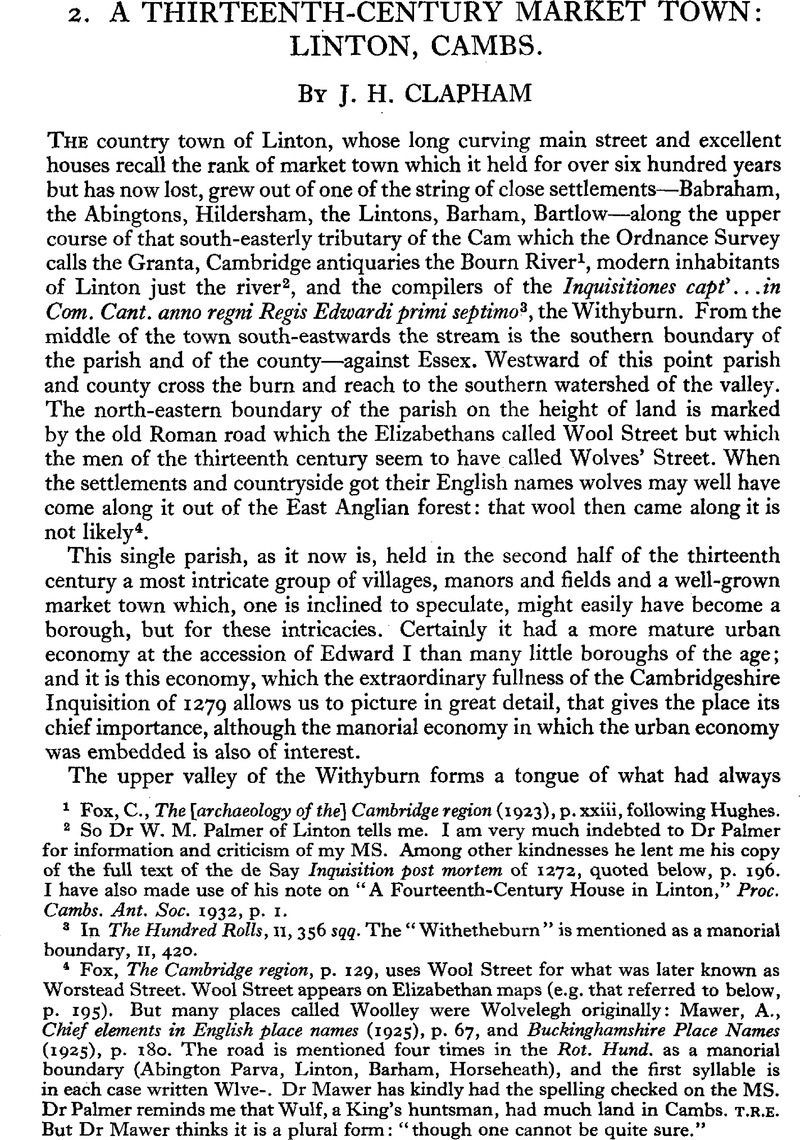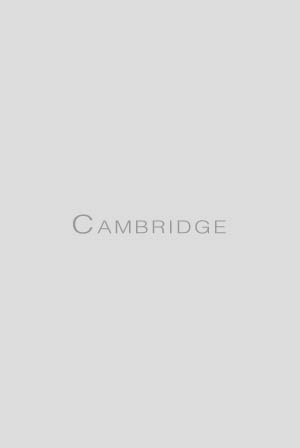Article contents
A Thirteenth-Century Market Town: Linton, Cambs
Published online by Cambridge University Press: 20 December 2011
Abstract

- Type
- Notes and Communications
- Information
- Copyright
- Copyright © Cambridge University Press 1933
References
1 Fox, C , The [archaeology of the] Cambridge region (1923), p. xxiii, following Hughes.
2 So Dr W. M. Palmer of Linton tells me. I am very much indebted to Dr Palmer for information and criticism of my MS. Among other kindnesses he lent me his copy of the full text of the de Say Inquisition post mortem of 1272, quoted below, p. 196. I have also made use of his note on “A Fourteenth-Century House in Linton,” Proc. Cambs. Ant. Soc. 1932, p. 1.
3 In The Hundred Rolls, II, 356 sqq. The “Withetheburn” is mentioned as a manorial boundary, II, 420.
4 Fox, The Cambridge region, p. 129, uses Wool Street for what was later known as Worstead Street. Wool Street appears on Elizabethan maps (e.g. that referred to below, p. 195). But many places called Woolley were Wolvelegh originally: Mawer, A., Chief elements in English place names (1925), p. 67Google Scholar, and Buckinghamshire Place Names (1925), p. 180. The road is mentioned four times in the Rot. Hund. as a manorial boundary (Abington Parva, Linton, Barham, Horseheath), and the first syllable is in each case written Wive-. Dr Mawer has kindly had the spelling checked on the MS. Dr Palmer reminds me that Wulf, a King's huntsman, had much land in Cambs. T.R.E. But Dr Mawer thinks it is a plural form: “though one cannot be quite sure.”
5 The accounts of the Linton manors here used are in R.H. II, 416 sqq.
6 See the Roman map in Fox, The Cambridge region.
7 D.B. 1, 194 a.
8 The bounds are given in R.H.
9 Bounds also in R.H.
10 D.B. 1, 191 a and 193 b.
11 Which is given as the boundary in R.H. But in the sixteenth century, and perhaps earlier, some scraps of Barham land lay south of the stream. See the Lynton towne Mapp with the mapp of the whole Manour of Bergham als. Berham in the sayd towne of Lynton, 1600: in the muniments of Pembroke College. Barham Hall, Dr Palmer has pointed out to me, is not on the site of the old manor house, though close to it.
12 This is not the place to discuss “garrison,” or other, theories of borough origins. Maitland noted the Linton-Cambridge burgesses (Domesday Book and Beyond, p. 182) but not how badly ten men from a solitary manor in the shire fit a strict “garrison” theory.
13 For all Cornwall, a notoriously “servile” county, there were 21 per cent.
14 The stock is given in the Inquisitio Comitatus Cantabrigiensis (ed. Hamilton, N. E. S. A.), pp. 33–4. And see Ballard, A., The Domesday Inquest, p. 234, for domain stock in general. For enclosure and fields in Little Linton, see below, n. 20.
15 Farrer, W., Feudal Cambridgeshire (1920), p. 65 and pp. 59–60, summarises the feudal history of Linton and Barham: he gives all these facts.Google Scholar
16 This fact, and those which follow, are from the R.H.
17 Farrer, Feudal Cambridgeshire, as above.
18 Lysons, , Magna Britannia, II (1810), 228 for the fair: market day is given in the 1272 Inquisition post mortem, mentioned above, n. 2: it is No. 37 of 56 Henry III.Google Scholar
19 Miss H. M. Cam of Girton helped me to follow up this saint, and in other ways. The saint was the son of St Gwen and has given his name to Jacobstow in Cornwall.
20 Chilford Field appears on the map of 1600. The others are nineteenth-century names from the time of the enclosure, 1838–40. The award is in the County Hall, Cambridge. There is also an outline road and field map in the University Library. The maps and the field names of Little Linton indicate old enclosure there: fields are “Old Park,” “New Park,” etc.
21 Maps, as above. By 1600 there are a number of lands and closes in the northeast of the manor marked “late heath”: the bruera had been curtailed. By 1840 there are four fields in Barham—Brick Kiln Ley, White Eye, Little Hill, and Barham Field. Barham Field looks almost as big as all the rest together, but t he old boundaries are not made clear in the Enclosure Award map.
22 The mill site is shown on the 1600 map. In 1279 de Furnels also had a molendin’ ventric. The map shows a few Barham houses on the far eastern edge of the parish, adjacent to the next village, Bartlow, as the western houses were adjacent to Linton.
23 On the 1600 map, “baker's croft” and “Hugh Baker's croft,” at the eastern end of the town street, recall these people. There is vicarage land close to them.
24 Farrer, Feudal Cambridgeshire, p. 60. The estate of Michael de Furnels, under the name of Michaelots, ultimately became a distinct property; Palmer, Proc. Cambs. Ant. Soc. 1932, p. 3.
25 Cp. Tait, J., “The study of early municipal history in England,” Proc. Brit. Acad. 1922–1923, p. 215. Burgage tenure may of course be older than 1246.Google Scholar
26 Made by Hemmeon, W. de M., Burgage Tenure [in Medieval England] (1914), p. 157. Burgage in villages was referred to by Pollock and Maitland, H.E.L. I, 673.Google Scholar
27 British Borough Charters, 1216–1307, ed. Ballard and Tait (1923), p. li. Burgage outside boroughs has been found chiefly in market towns on ancient demesne.
28 Had it not, he would presumably have quoted it in the H.E.L.
29 The passage in the King's Library copy of the R.H. is doubly underlined by him and “burgesses” written in pencil in the margin. Dr Palmer has also noted the existence of the burgage holdings, Proc. Cambs. Ant. Soc. 1932, p. 1.
30 From the I.P.M. quoted above.
31 Hemmeon, Burgage Tenure, p. 67.
32 Hemmeon as above. The high Linton figures can hardly represent rents for mere market stalls, one would think. Probably the shoppœ were of many sorts.
33 Presumably le Shobegge’ (? Shobogge’ =shoe-botcher) was a cobbler. Dr Coulton agrees that this is a likely explanation.
34 E.g. Castle Camps in Cambridgeshire: land in pledge of five Jews of London and Cambridge, 1236. Farrer, Feudal Cambridgeshire, p. 69.
35 I.e. Walker. Dr Coulton thinks this “seems pretty certain.”
36 I do not care to multiply by 5 as is sometimes done, but 3½ seems too conservative.
37 This comes to about two “works” a week for the single full holding of 32 acres.
38 Dr Palmer comments on this query: “it had become a green. In 1328 the lord of the manor planted it with trees, but the freeholders cut them down.” But perhaps this is not quite decisive for 1279: the lords agents in 1328 may have wished to restore a dilapidated “holt.”
39 Miss H. M. Cam feels sure, and Dr Palmer thinks, that the women are accidents. I am not yet convinced of this.
40 Farrer, Feudal Cambridgeshire, pp. 178 (Caxton), 144 (Burwell).
41 R.H. 11, 499 (Burwell), 540 (Caxton).
42 Lysons, Magna Britannia, 11, 228. The July fair was the Furneaux, not the de Say, fair. Above, p. 197.
43 All these tenurial changes are given in Farrer, Feudal Cambridgeshire. Dr Palmer thinks that the change of ownership from the “powerful family” of de Say was the main reason why there was no further development. The heir in 1272 being a minor the estate was wasted.
44 Palmer Proc. Cambs. Ant. Soc. 1932, p. 8.Google Scholar
- 2
- Cited by


